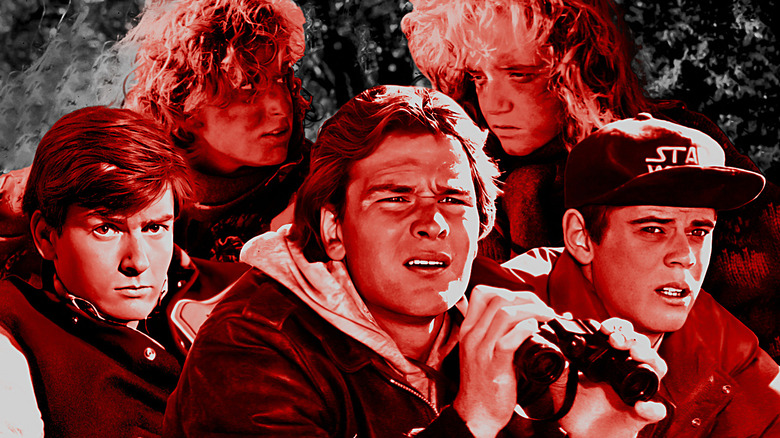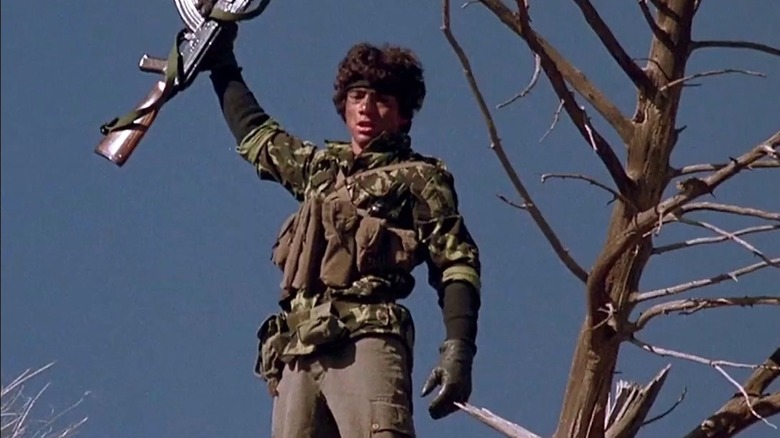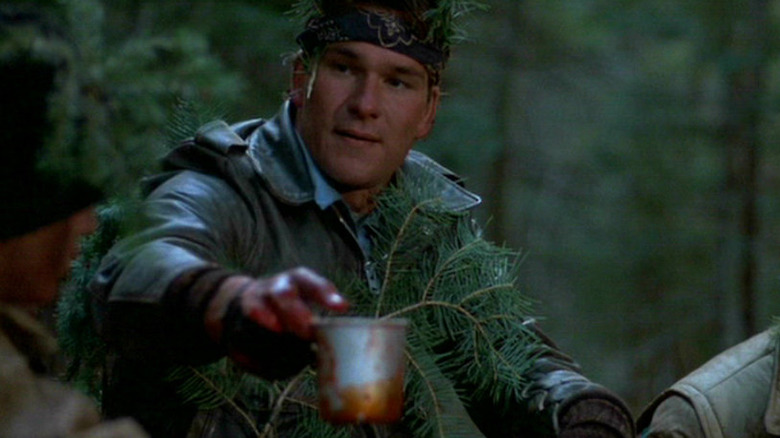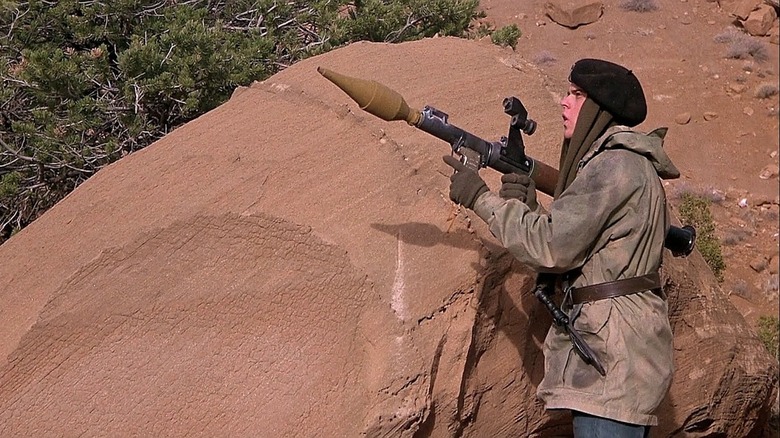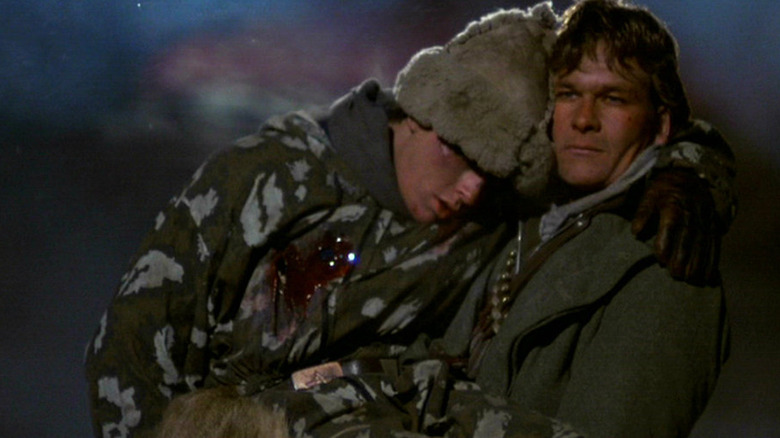The First PG-13 Movie Was Called The Most Violent Movie Ever Made
The minute Mola Ram (Amrish Puri) sunk his digits into the chest of one very unfortunate Thuggee cultist and extracted his still-beating heart for his followers — and moviegoers all over the world — to see, the Motion Picture Association of America (now the Motion Picture Association) finally had to admit it had a ratings problem on its hands.
This horrific scene arrives halfway through Steven Spielberg's "Indiana Jones and the Temple of Doom," the kickoff film of the 1984 summer movie season, and as the sequel to 1981's box office champ "Raiders of the Lost Ark," easily the year's most anticipated release. Like its predecessor, it was sold as an all-ages adventure, which the MPA certified with a PG rating. For 12 years, PG suggested "Parental Guidance," though most parents treated the rating as a guarantee they could drop off their kids at the theater secure in the knowledge there would be no f-bombs, no significant nudity, and no graphic violence. So when some children returned home traumatized by an act many believe should've triggered an automatic R rating (thus requiring adult accompaniment for anyone under 17 years old), watchdog groups like Action for Children's Television and the United States Catholic Conference went berserk.
Then two weeks later, Joe Dante went and exploded a Gremlin in a microwave, forcing the MPA's notoriously stubborn president Jack Valenti to relent and pursue a new ratings alternative.
On July 1, 1984, the MPA introduced its PG-13 rating, which "strongly cautioned" parents that a film contained material that might rattle kids under that designated age. To the dismay of some, it was not a restrictive rating, but most of the MPA's critics were mollified that, if nothing else, their concerns had been heard. Still, no one knew what a PG-13 film would look like.
They got their answer a month later when John Milius' relentlessly, record-breakingly violent "Red Dawn" parachuted into theaters nationwide. And they were not pleased.
Teenagers tangle with an invading commie horde
Of the 1970s film brats (a brashly talented group that included Spielberg, George Lucas and Brian De Palma), John Milius was a bit of a Hollywood throwback. Heartbroken that he couldn't serve in the Vietnam War due to his asthma, he worked out his frustrations in screenplays that investigated humanity's fervent desire for combat. He scored a minor hit with the 1975 desert adventure "The Wind and the Lion," earned an Oscar nomination for co-writing "Apocalypse Now" with Francis Ford Coppola in 1979, and made Arnold Schwarzenegger a movie star with 1982's "Conan the Barbarian." His 1978 surfing ode aside, Milius' brand was brutality.
"Red Dawn" did not originate with Milius. It started as a melancholy, smaller-in-scale antiwar parable written by Kevin Reynolds ("Waterworld"), who probably would've directed the film had he not whiffed on "Fandango." Thanks to Alexander Haig, Ronald Reagan's disgraced former Secretary of State and MGM board member, Milius took over the project and immediately rewrote it as a World War III fantasy about high school kids bedeviling a U.S.S.R.-backed invasion of the United States via guerrilla warfare.
Milius' instincts were perfectly in sync with the overall national mood of the mid-1980s. The Vietnam War was ten years in the rearview, and a vocal segment of the American public, having learned nothing from that conflict (and undeterred by the threat of a planet-wrecking, full-scale nuclear war), were spoiling for a boots-on-the-ground slugfest with the Russkies. This was Milius' chance to make a war movie on his political terms, to postulate a worst-case scenario based on the perceived communist threat developing in Central America and get bloodthirsty moviegoers off with the stand-up-and-cheer spectacle of patriotic teenagers fighting for their country on their soil.
It was also, professionally, an opportunity to establish himself as a reliable commercial filmmaker. So Milius cast aside the ambiguity of "Apocalypse Now" and the visual poetry of "Conan the Barbarian," and served up a bloody rare steak with Patrick Swayze leading the charge.
How Red Dawn became the MPA's PG-13 test case
The MPA was speeding toward a ratings reckoning before cameras even began rolling on "Red Dawn." Parents were still sore over the Spielberg-produced nightmare machine that was "Poltergeist," and they were starting to notice that the association was getting a little lax with its content guidelines. The most egregious example arrived three weeks prior to Mola Ram's shenanigans in the bodacious, close-up form of a body double's breasts in John Hughes' "Sixteen Candles." PG-rated movies got away with a bare butt here and there, but this? This was hilariously gratuitous.
So there's a case to be made that "Red Dawn," which features no nudity and nary an f-bomb, might've slipped by with a PG. Indeed, you could say Milius and MGM were strategically courting the rating by not crossing these redlines.
But in a post-Mola Ram world, the early scene where Patrick Swayze pours a cup of deep-red blood for C. Thomas Howell to drink as ritual for having killed his first deer likely forced the MPA's hand. When the first film to receive a PG-13, Garry Marshall's lovely "The Flamingo Kid," had its release delayed, "Red Dawn" was set to be the canary in the cineplex coal mine. This attention, combined with the movie's unremitting carnage and hot-button political hook, turned Milius' mid-ranger into a kind of event movie.
"Red Dawn" provoked strong responses across the board. Conservatives applauded its jingoism, kids went nuts over the sight of teenagers taking it to the invading Commies and the country's self-appointed cultural police declared it a miscarriage of ratings justice. In their view, "Red Dawn" wasn't just an exceptionally violent motion picture, it was the most violent motion picture ever made. And they claimed to have the numbers to prove it.
Hollywood versus the media scolds
"Red Dawn" won its opening weekend at the U.S. box office (besting a still-chugging, two-months-into-its-release "Ghostbusters"), which meant opportunistic media scolds could get their names in the newspapers by decrying its wanton bloodshed. An August 13, 1984 New York Times article let a variety of concerned adults voice their displeasure over the non-restrictive PG-13 rating, while allowing Paramount Pictures chairman Barry Diller to deliver a measured mea culpa acknowledging that the industry had been too slow in addressing the concerns over the overly broad PG.
The tenor of the NYT piece is slightly foreboding, with some critics worrying that the MPA's too-little-too-late response could kick open the door for local censors to apply their own standards in determining who can see what and, more troubling, what can be shown in the first place. The most aggressive objections are voiced by psychiatrist Dr. Thomas Radecki, the head of the National Coalition on Television Violence. Radecki was making a name for himself around this time with his attacks on the role-playing-game Dungeons & Dragons, which he claimed was driving young men to do harm to themselves and others. He viewed "Red Dawn" as exhibit A in his crusade to set up local ratings boards in cities all over the country. To bolster his cause, he asserted that "Red Dawn" featured 134 violent acts per hour. Guinness World Records did its own counting, and concluded that, yes, "Red Dawn" was the most violent movie made to that point.
What felt like an inflection point in the nation's hand-wringing over the corrupting influence of media on impressionable children — and, in Radecki's opinion, adults, as he believed the hack-and-slash antics of Jason Voorhees could drive men to commit rape — gradually died down for three reasons: one, there is no hard scientific proof that violent movies (or video games) drive people to commit violence in real life; two, the MPA eventually got more aggressive in assigning R-ratings to particularly violent movies; and three, "Red Dawn" got unseated as the most violent movie ever the following year.
The acceptance and utter marketplace dominance of the PG-13 rating
Initially, the PG-13 rating proved effective at getting the watchdogs off their back. Meanwhile, some of these watchdogs played a crucial role in their own demise. Radecki was discredited several times over in his attempts to link Dungeons & Dragons to violent real-life acts, had his medical license suspended in 1992 for alleged sexual misconduct, and in 2016, he was sentenced to 11-22 years in prison for having traded opioids in exchange for sexual favors.
Four decades later, in terms of theatrically released movies, the PG-13 has become the catch-all rating for anything that isn't an animated children's film or a movie for adults. The major studio franchises all target the PG-13 rating, and they ensure there won't be a ratings controversy by setting stories in CG-laden unrealities where blood rarely flows, no one has sex (onscreen at least), and f-bombs are elided with only one exception allowed. Is it possible "Deadpool & Wolverine" and "Joker" could get studios taking more managed R-rated risks on big-budget movies? Maybe, but they'll mostly be R-rated movies in kid-friendly genres.
Of course, "Red Dawn" is a kids' movie, too, one that would absolutely receive an R-rating in 2024. The remake? Yeah, that really did happen in 2012, and it was as bloodless as a random episode of "The A-Team" (and it was also politically incoherent). As for the film that knocked "Red Dawn" from its perch as the most violent movie of all time, that would be "Rambo: First Blood Part II," which was conceived as an R-rated movie and thus could slather on the gore with meatheaded abandon. Mola Ram would've loved it.
